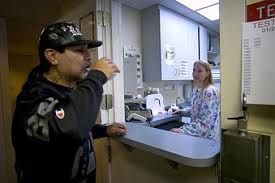Methadone Treatment Basic Facts
Information on the website of the Centers for Disease Control (CDC) features the following information about methadone treatment for people who are having problems with opiate addiction:
- Methadone Maintenance Treatment (MMT) began in the 1960’s. Medication along with vocational and social counseling is part of methadone treatment
- Untreated Opioid Addiction costs 20 Billion dollars per year
- Up to 10,000 people die per year from IV drug use
- Methadone Treatment stops opioid cravings
- Methadone Treatment stops opioid withdrawal
- Methadone is taken once per day
- 70-80% of Methadone Patients have Hepatitis B
- Methadone Maintenance Treatment is very effective
- Methadone Treatment is available in most cities
Problems with opioids have gone back hundred’s of years. Some treatment approaches need a very high level of motivation (abstinence, therapeutic communities, step programs) and are not helpful for many. Methadone treatment can help on it’s own, or help those where other addiction treatment has not helped. So what’s in it for you?
The Benefits of Methadone Treatment:
- Patients stop or reduce injecting drugs
- Reduction of the use of opioid drugs
- Decrease of transmission of blood borne illnesses
- Patients have healthier babies
- Patients have more stable employment and a more stable family
- 30% reduction in early death
- Less criminal activity
Methadone Treatment : How Safe is It?
Using an opioid that is prescribed and monitored by a physician for the treatment of opioid addiction has been used in the United States since the 1800’s. In fact, around 1914 several thousand doctors went to prison for prescribing opioids to their addicted patients after the Harrison Act. It prohibited this type of drug treatment. Only until recently, have patients been getting steered by society toward treatment. Between 1914 and around 1970, addiction was basically criminalized and many simply ended up in jail.
Methadone treatment has been studied since the 1960’s. The White House Drug Policy Fact Sheet on Methadone states the following “When methadone is taken under medical supervision, longterm maintenance causes no adverse effects to the heart, lungs, liver, kidneys, bones, blood, brain, or other vital body organs.” When taken appropriately, methadone doesn’t have serious side effects. The are some side effects of methadone (and a related medication suboxone).
When taken as directed, methadone will not cause a problem with your employment. You will not suffer from a change in your intelligence from methadone treatment. You should be able to drive without problems with being sedated. Although methadone is an opioid medication, at the correct dose, it will not cause a person to “get high” and it will prevent any opioid withdrawals from occurring.
Methadone treatment has been the standard for treating opioid addicted pregnant patients. The substance abuse and mental health administration has a pamphlet that discusses this information in more detail. We now have 40 years of experience managing patients on methadone who are pregnant.
Finally, methadone treatment is highly monitored. In fact, it is one of the most monitored treatments in the United States. The chain from the methadone manufacturer all the way down to the requirements of clinic are watched closely. The Drug Enforcement Administration along with State Agencies keep close tabs on the clinics to ensure their safety.
Summary of Methadone Treatment Facts:
Methadone treatment is a highly monitored, safe treatment for opioid addicted individuals. We have over 40 years of experience with the use of methadone and it has been well studied. Methadone has helped hundreds of thousands of individuals break the cycle of addiction, get back their families, and maintain employment. It keep people out of prison and improves their lives. See the links below for more methadone treatment information including suboxone treatment.
Here are some other methadone treatment useful links:
Suboxone Treatment : This is another alternative for the treatment of Opioid Addiction. It is a medication based treatment and works well. This site has a suboxone doctor directory and helpful articles on suboxone.
Centers for Disease Control : This link will bring you directly to the the source pdf for this article.
White House Drug Policy : This link brings you to more information on methadone and other sources. It is another pdf file.
Suboxone Treatment Directory And Methadone Treatment Directory
Dr. Rich is a Board Certified Psychiatrist with licenses in Texas and Hawaii. He specializes in the treatment of opioid addiction with buprenorphine and runs a FREE locator service to find Methadone Treatment including Suboxone treatment of oxycontin addiction. Find a Suboxone Treatment Clinic in your area.
Dr. Rich has written more articles on the cost of oxycontin, buprenorphine (Suboxone) including frequently asked questions and a recent post : How Do I Find A Suboxone Physician?

